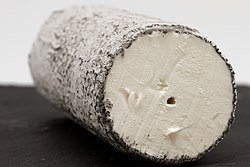Sainte-Maure de Touraine
This article needs additional citations for verification. (March 2013) |
| Sainte-Maure de Touraine | |
|---|---|
 | |
| Country of origin | France |
| Region, town | Touraine |
| Source of milk | Goat |
| Pasteurised | Traditionally no |
| Texture | Soft-ripened |
| Aging time | at least 10 days |
| Certification | French AOC 1990 |
| Named after | Sainte-Maure-de-Touraine |
Sainte-Maure de Touraine is a French cheese produced in the province of Touraine, mainly in the department of Indre-et-Loire. It is named after the small town of Sainte-Maure-de-Touraine, in the department of Indre-et-Loire, at equal distance from westly Chinon and eastly Loches.
Sainte-Maure de Touraine is an unpasteurized cheese made from full fat goat's milk.[1] It has the form of a small log,[1] around 16–17 cm in length, and weighs at least 250 g. It is white and soft under a greyish moldy rind and is rolled in wood ash.[2] It has a straw through its centre, marked by the AOC seal and a number indicating the producer. The straw is used, in the making, to keep the roll together. The finished cheese has 45% milkfat.
Quality control
Protected since 1990 by the AOC Seal, Sainte-Maure de Touraine is made with traditional methods. It should not be confused with "Sainte-Maure", also produced in Touraine, but without meeting the stringent AOC production criteria. "Sainte-Maure" is the industrial counterpart of the high-quality, traditionally made, Sainte-Maure de Touraine. Their straw is not marked by a seal, thus differentiating them from AOC cheeses.
Production
1,065 tons of Sainte-Maure de Touraine were produced in 2003,[3] 58% on dairies and 42% on farms. Since it became an AOC in 1990, its production has strongly increased, from 275 tons (a nearly 300% increase). It is now the second largest produced goat's cheese AOC in France, just behind Crottin de Chavignol.
See also
References
- ^ a b Jenkins, S.W. (1996). Cheese Primer. Workman Pub. p. 124. ISBN 978-0-89480-762-6. Retrieved March 30, 2018.
- ^ "The Everything Cheese Book, Laura Martinez".
- ^ [1][dead link]
